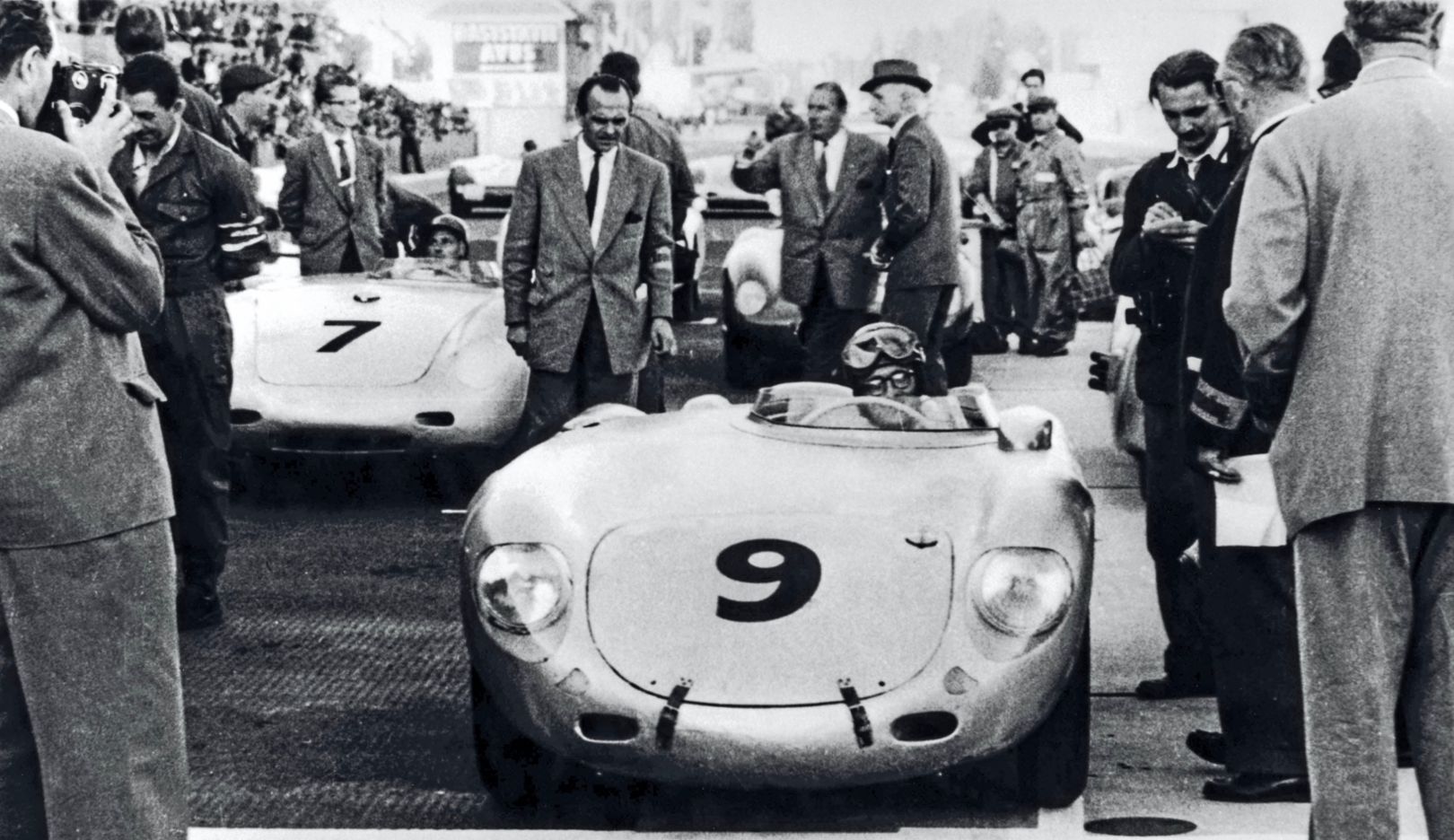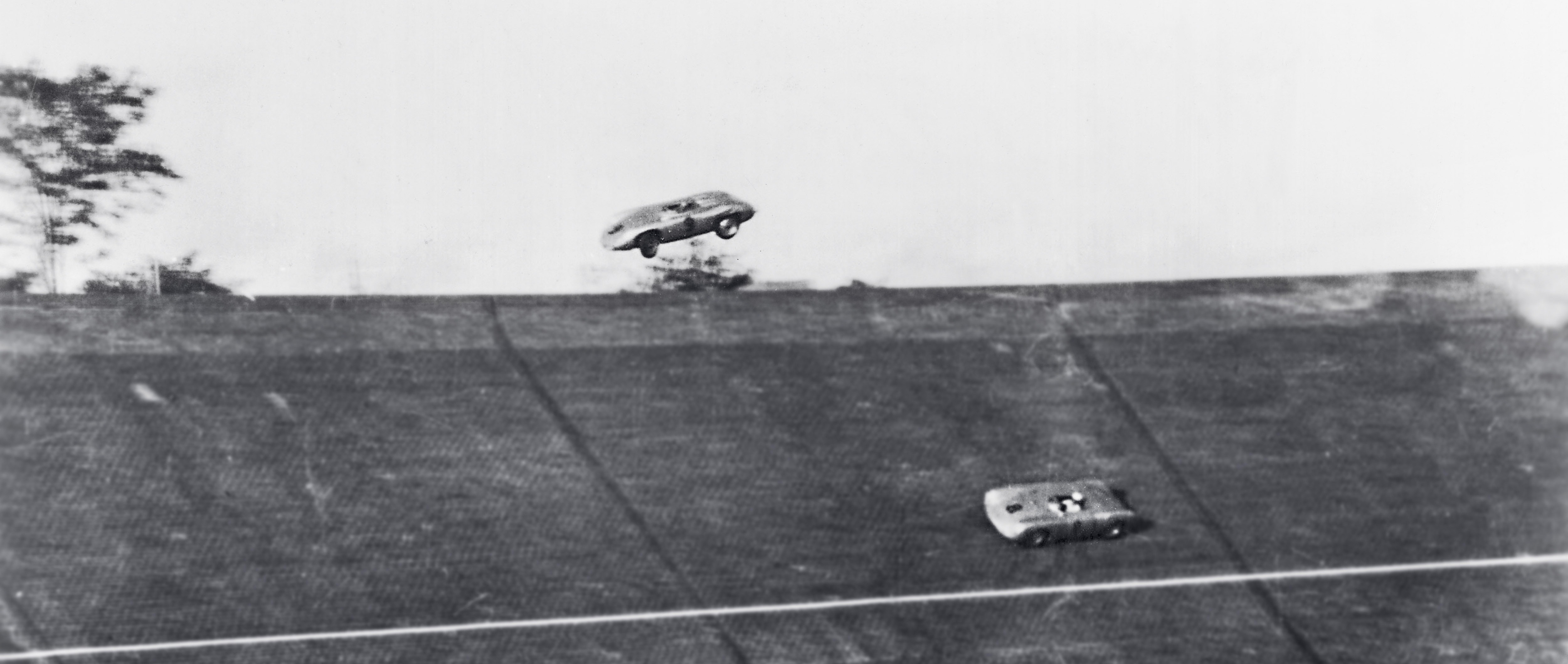Between Heaven and Earth
The Avus racecourse opened in Berlin one hundred years ago. This high-speed track—with its high-banked curve—became the venue for legendary competitions. Richard von Frankenberg, race-car driver and founder of Christophorus, loved this circuit although it very nearly cost him his life. His son looks back.
My father felt at home on superfast racecourses. One of these was the Avus in Berlin. The Automobil Verkehrs- und Übungsstraße (“automobile and training track”), which opened in 1921, consisted of two 8.2-kilometer stretches connected by two sharp curves. In 1937, one of the curves was banked to make the course even faster. The infamous bricked banking on the north curve (Nordkurve) had an awe-inspiring gradient of 43 degrees, a radius of 184 meters, and a height of more than twelve meters. Cars could take it at around 180 kilometers per hour. The curve was a monster: Juan Manuel Fangio complained of headaches, Wolfgang Graf Berghe von Trips felt sick to his stomach, and Hans Herrmann’s head was pushed so far down by the centrifugal force that the only thing he could see was the gas pedal. Moss grew between the bricks on the surface, which meant the north curve was always a little damp.
These enormous challenges were precisely the reason why my father loved the Avus. He lived for speed, and not only on racecourses. In his professional life, too, he preferred the fast lane. In 1952, as a freelance contributor he founded Christophorus, “the magazine for friends of Porsche,” and remained its editor-in-chief for many years. At the time, Fritz Huschke von Hanstein was both head of public relations and the race director. My father was a Porsche factory driver from 1953 to 1960, posting class victories on many of the world’s leading courses, including Le Mans and the Nürburgring.
The last race of the 1954 season of the German Sportscar Racing Championship was held on the Avus. The north curve always put a huge strain on the tires. A section of tread broke off my father’s Porsche 550 Spyder during a training run at 180 kmh, but he managed to keep the car under control. A special set of tires was installed for the race. For twenty laps my father went head to head with Hans Herrmann, who was also in a 550 Spyder. In the last lap my father braked later entering the south curve, which enabled him to win the race. He had completed the 168 kilometers at an average speed of 193.5 kilometers per hour.

“I will never forget all that black smoke.” Donald von Frankenberg
In 1955, the distance for the contest was set at 249 kilometers. During the training session, my father only placed third in his 550 Spyder, starting behind two EMWs from East Germanys Eisenacher Motorenwerk driven by Edgar Barth and Arthur Rosenhammer. But my father put in one of the finest performances of his life, taking the lead right away and defending it to the finish with three EMWs in hot pursuit the entire time. The final results speak for themselves: the 550 Spyder, the three EMWs, and another Porsche 550 Spyder back in fifth place.
The 645 Spyder prototype was christened “Mickey Mouse” by Porsche’s engineers and mechanics, who had developed it within a short period of time in 1956. Every Porsche race car was made by hand down to the very last bolt, and each one had specific qualities that gave it its nickname. The Mickey Mouse had a tubular space frame and a shortened wheelbase and track width. To lower its weight, it used magnesium in numerous places. This lightweight metal has good strength properties but ignites at 648 degrees Celsius and burns at high heat with a blinding white light. It is nearly impossible to extinguish.
The Mickey Mouse was considerably lighter and more advantageous aerodynamically than the 550 A Spyder. That gave it a higher peak speed—260 kilometers per hour—in comparison to the 550, while producing the same output of 135 PS. However, the trade-off came in its handling properties. Even on the straights it could hardly be controlled. It acted like a mouse fleeing for its life from a cat—which led to the nickname.
On the Porsche factory team, neither Hans Herrmann nor Wolfgang Graf Berghe von Trips was willing to drive the car. But my father was. He had a high tolerance for risk.

Father and son
Richard von Frankenberg with young Donald at Le Mans in 1955. Ferry Porsche stands at the front left.In 1956, the final race of the German Sportscar Racing Championship was again held on the Avus. Having won the race in 1955, my father entered it this year as the defending champion. He, Hans Herrmann—who had won the German Championship in 1954—and Graf Trips were the favorites. By the end of the first lap, my father had taken the lead. In the third lap, his car suddenly deviated from the racing line on the high-banked curve, shot over the banking at 180 kmh, flipped, disappeared from sight, and crashed down into the drivers’ camp. A big plume of black smoke made us fear the worst. The Mickey Mouse was burning fiercely with a full tank of gas.
I don’t recall the scene of the accident itself. What I do remember is my mother grabbing my hand in the bleachers at the start-and-finish line and running toward the north curve. I will never forget all that black smoke. Our greatest fears were finally allayed by an announcement that came over the loudspeaker—my father had been found unconscious but alive in the bushes behind the curve. Without a seat belt, he had been catapulted out of the car and the hedges on the far side of the banking had cushioned the impact. The fact that he had survived the accident was nothing short of miraculous. He spent five weeks in a Berlin hospital, much of that time on his stomach. His back had suffered severe soft-tissue injuries from the centrifugal force that had hurled him out of the car. And the concussion he sustained from the impact erased his memory of the third lap.
By December of 1956, he had recovered sufficiently to attend the Porsche Christmas party, walking with a cane. Publication of the twenty-third issue of Christophorus was postponed. When it appeared, his laconic foreword as editor-in-chief asked readers to pardon the delay: “Before completing this issue of Christophorus, I first had to more or less overcome a concussion and severe bruising—which I’m sure you’ll understand.” That, in a few words, was what my father was like.

